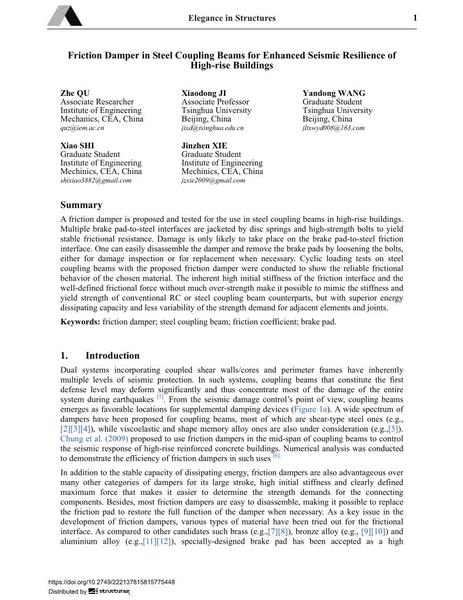Friction Damper in Steel Coupling Beams for Enhanced Seismic Resilience of High-rise Buildings

|
|
|||||||||||
Bibliografische Angaben
| Autor(en): |
Zhe Qu
Xiaodong Ji Yandong Wang Xiao Shi Jinzhen Xie |
||||
|---|---|---|---|---|---|
| Medium: | Tagungsbeitrag | ||||
| Sprache(n): | Englisch | ||||
| Tagung: | IABSE Conference: Elegance in structures, Nara, Japan, 13-15 May 2015 | ||||
| Veröffentlicht in: | IABSE Conference Nara 2015 | ||||
|
|||||
| Seite(n): | 376-377 | ||||
| Anzahl der Seiten (im PDF): | 8 | ||||
| Jahr: | 2015 | ||||
| DOI: | 10.2749/222137815815775448 | ||||
| Abstrakt: |
A friction damper is proposed and tested for the use in steel coupling beams in high-rise buildings. Multiple brake pad-to-steel interfaces are jacketed by disc springs and high-strength bolts to yield stable frictional resistance. Damage is only likely to take place on the brake pad-to-steel friction interface. One can easily disassemble the damper and remove the brake pads by loosening the bolts, either for damage inspection or for replacement when necessary. Cyclic loading tests on steel coupling beams with the proposed friction damper were conducted to show the reliable frictional behavior of the chosen material. The inherent high initial stiffness of the friction interface and the well-defined frictional force without much over-strength make it possible to mimic the stiffness and yield strength of conventional RC or steel coupling beam counterparts, but with superior energy dissipating capacity and less variability of the strength demand for adjacent elements and joints. |
||||
| Stichwörter: |
Reibungsbeiwert
|
||||
